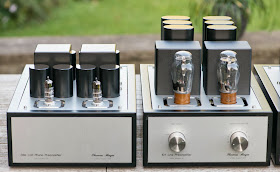Today's post will show the assembly process of a new incarnation of the Octal Preamplifier line, the Mk3.
Previous versions of the Octal Preamplifier have already been presented on this blog. The Mk1 was the first in the line which got an upgraded version, the Mk2 (photos here). The Mk3 version merges the circuits of the Octal Phono Preamplifier and the Octal Line Preamplifier into one chassis. In order to fit it into a single chassis the simpler version of the power supply has been used without any chokes.
The Mk3 version does not render the Mk1 or Mk2 obsolete. They are different circuits and represent preamplifier implementations at different cost and sound levels. The Mk3 represents the lowest cost version, the Mk1 is in the middle and the Mk2 remains the best sounding (and highest cost) version of the three.
The assembly starts with the top metal plate, here with tube sockets and power transformer mounted:
The tube sockets are mounted with vibration damping rubber elements:
First the heater wiring is done. I decided to leave the line tubes on AC and the phono tubes are heated with DC. The high voltage AC leads to the power transformer are also in place already:
Next some solder terminal strips get mounted. These will hold all the passive components:
Solder terminals stuffed with all the passives:
The face plate holds on/off switch, volume control potentiometer and the input selector switch. As much as possible is prewired before the face plate is inserted into the chassis:
The same with the back plate, all wires from the input jacks and to the output jacks are already soldered to the connectors. The MC step up transformer is mounted directly besides the phono input jacks:
The MC step up is a Lundahl LL1681. It is connected to two switches, one per channel, which allow selection of the step up ratio between 1:13 (for higher input impedance) and 1:26 for low input impedance and maximum gain. Switching is done as already shown on a spearate MC step up unit.
Front and back plates inserted and ready to be wired up:
wiring all the inputs to the selector switch is the most tedious job during the build process. All input wires are twisted with a ground wire for shielding. This ground wire is only connected at one end. There are separate ground connections for the inputs and the output. One wire for all inputs and one for the output. These are connected to the ground point of the line stage part.
Mains AC wires are covered with an extra insulation sleeve. Also the input and output wires for protection:
Wires are purposely not bundled to minimize crosstalk. Looks messy but works better. Now the bottom plate and transformer cover remain to be attached and the preamp is ready to play:
This preamp is the first to use my new transformer covers.
Top View:
The back side with all connections:
Phono input on the left (MC only). Two switches to select between 1:13 and 1:26. Next three line level inputs and the output jacks. On the bottom left is the ground lift switch.
Some views of the tubes:
The next project will be an integration of this preamp circuit with the low cost variant of the 6CB5A amplifier. This will be a fully integrated amplifier with phono on board. Stay tuned!
Best regards
Thomas









































































